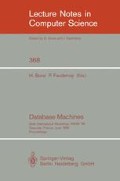Abstract
In this paper, we describe the structure and utilization of a high bandwidth, multi-ported, disk-sized memory system capable of storing, maintaining, and manipulating persistent shared data within it, independent of any external processing units. Up to thousands of active storage elements, each element having some storage and some associated processing logic, function independently or in groups to implement user-defined objects and data structures. Hundreds of transactions can concurrently be processed by mutually exclusive sets of elements. A fast response time is obtained due to the proximity of the processing with the memory, a specialized micro-architecture, and parallelism.
Preview
Unable to display preview. Download preview PDF.
References
R. Agrawal and D.J. DeWitt, “Whither Hundreds of Processors in a Database Machine,” Proc. Int'l Workshop High-Level Computer Architecture 84, May 1984, 6.21–6.32.
R. Agrawal and H. V. Jagadish, “Recovery Algorithms for Database Machines with Non-Volatile Main Memory,” AT&T Bell Laboratories Technical Memorandum, 1989
Anon, et al., “A Measure of Transaction Processing Power,” Datamation, Apr. 1, 1985, 112–118.
B. A. Crane et al, “PEPE Computer Architecture,” in IEEE CompCon, 1972, 17–22.
J. A. Chandross, H. V. Jagadish, and A. Asthana, “The Trap as a Control Flow Mechanism,” Proceedings of MICRO 21, the 21st Annual Workshop on Microprogramming and Micro-Architecture, Dec. 1988.
G. Copeland, R. Krishnamurthy, and M. Smith, “The Case for Safe RAM,” Tech. Rept. ACA-ST-080-88, MCC, Austin, Texas, Feb. 1988
D.J. DeWitt, “DIRECT — A Multiprocessor Organization for Supporting Relational Database Management Systems,” IEEE Trans. Computers, C-28(6), June 1979, 395–406.
H. Garcia-Molina, R. J. Lipton, and P. Honeyman, “A Massive Memory Database System,” Technical Report #314, Dept. of Elec. Engg. and Comp. Sc., Princeton University, Sep. 1983
N.H. Gehani and W.D. Roome, “Concurrent C,” Software—Practice & Experience, 16(9), 1986, 821–844..
D. Hillis, The Connection Machine, MIT Press, Cambridge, Mass., 1985.
E. Neuhold and M. Stonebraker, “Future Directions in DBMS Research,” Technical Report-88-001, Int'l Computer Science Inst., Berkeley, California, May 1988
Craig Stanfill, presentation on, “Pattern Matching on the Connection Machine,” Third International Conference on Supercomputers, Boston, MA, May 1988.
Esen. A. Ozkarahan, Stewart A. Schuster, and K. C. Smith, “RAP — An Associative Processor for Data Base Management,” in Proceedings 1975 National Computer Conference, vol. 44, AFIPS, 370–387.
D. Patterson, G. Gibson, and R. H. Katz, “A Case for Redundant Arrays of Inexpensive Disks (RAID),” Proc. ACM-SIGMOD 1988 Int'l Conf. on Management of Data, Chicago, Illinois, June 1988.
W.D. Roome and M.D.P. Leland, “The Silicon Database Machine: Rationale, Design, and Results,” Proc. 5th Int'l Workshop on Database Machines, Karuizawa, Nagano, Japan, Oct. 1987.
Jack A. Rudolph, “A Production Implementation of an Associative Array Processor-STARAN,” in Proceedings of the 1972 Fall Joint Computer Conference, vol. 41, AFIPS, 229–241. Have this.
David Elliot Shaw, “The Non-Von Supercomputer,” Department of Computer Science, Columbia University, August 1982
D. L. Slotnick, “Logic Per Track Devices,” in Advances in Computers, vol. 10, Frantz Alt (ed.), Academic Press, New York, 1970, 291–296.
David J. Stoves, “CAFS800: Some Principles and Practices,” in Proceedings of the 5th International Online Meeting, and Learned Information, 1981. Paper Deals with CAFS.
B. Stroustrup, The C++ Programming Language, Addison-Wesley., 1986.
Stanley Y. W. Su, G. P. Copeland, and G. J. Lipovsky, “The Architectural Features of CASSM: A Cellular System for Non-Numeric Processing,” in Proceedings of the First Annual Symposium on Computer Architecture, 1983, 121–128. Paper deals with CASSM.
Author information
Authors and Affiliations
Editor information
Rights and permissions
Copyright information
© 1989 Springer-Verlag Berlin Heidelberg
About this paper
Cite this paper
Asthana, A., Jagadish, H.V., Knauer, S.C. (1989). An intelligent memory transaction engine. In: Boral, H., Faudemay, P. (eds) Database Machines. IWDM 1989. Lecture Notes in Computer Science, vol 368. Springer, Berlin, Heidelberg. https://doi.org/10.1007/3-540-51324-8_42
Download citation
DOI: https://doi.org/10.1007/3-540-51324-8_42
Published:
Publisher Name: Springer, Berlin, Heidelberg
Print ISBN: 978-3-540-51324-7
Online ISBN: 978-3-540-46197-5
eBook Packages: Springer Book Archive

